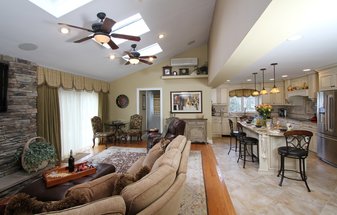
Dear Natalie,
I am working on changing out my window treatments in my den, which is connected to my kitchen. The issue is that my kitchen has a window with a window treatment on it that I want to keep, so I’m not sure how to handle matching the two? They are not next to each other, but can be seen from either room. Any advice would be helpful! ~ Joan P.
Dear Joan,
I am working on changing out my window treatments in my den, which is connected to my kitchen. The issue is that my kitchen has a window with a window treatment on it that I want to keep, so I’m not sure how to handle matching the two? They are not next to each other, but can be seen from either room. Any advice would be helpful! ~ Joan P.
Dear Joan,
Good question. With the open floor plan in many homes today, it is often an issue of co-coordinating without “matching”. The feeling and tone of your family room is an important consideration in choosing fabric, color and style for your window treatment. Also the location of your T.V. screen (for glare) in relation to your windows plays a part in the window covering which is different from the window dressing (area around the window or door).
Joan, if your den paint color, rug and upholstery fabric are the same in the same palette as your kitchen, (which would be ideal) your choices are simplified. If you've started your color scheme from the floor up, chosen neutral textural fabrics or leathers for upholstery and paint color next, it will be a lot easier to select fabrics for your window treatments. I often like stripes along with a mini or overall print to tie in all the colors. If the room is casual, use more casual cottons, if not, more formal designs are in order.
Cornices of varying shapes as well as simple top arrangements are often a good choice for dens because furniture is often placed against the window wall and draperies to the floor get lost and sometimes block the heat. The windows themselves are best covered with silhouettes, wood blinds (either real wood or vinyl look-a-likes), mini blinds or roller shades, all which can be hidden under the cornice or topper when not needed. Draw draperies with tab tops, on poles or under cornices are good for sliders or multiple sets of windows.
If there is a slider in both the den and kitchen, I’d use the same style window treatment. If variety is what you’re seeking, try reversing the fabrics and add some tassels or secondary fabric for trim. The goal is to color coordinate for flow and a sense of balance without being boring or redundant.
If you’re sewing, pick fabric, measure yardage and get to work. If you need a good workroom that will measure and install for you let us know and we can refer a source in your area as well as help you select a fabric that coordinate with your room.
Good luck- Nat
Joan, if your den paint color, rug and upholstery fabric are the same in the same palette as your kitchen, (which would be ideal) your choices are simplified. If you've started your color scheme from the floor up, chosen neutral textural fabrics or leathers for upholstery and paint color next, it will be a lot easier to select fabrics for your window treatments. I often like stripes along with a mini or overall print to tie in all the colors. If the room is casual, use more casual cottons, if not, more formal designs are in order.
Cornices of varying shapes as well as simple top arrangements are often a good choice for dens because furniture is often placed against the window wall and draperies to the floor get lost and sometimes block the heat. The windows themselves are best covered with silhouettes, wood blinds (either real wood or vinyl look-a-likes), mini blinds or roller shades, all which can be hidden under the cornice or topper when not needed. Draw draperies with tab tops, on poles or under cornices are good for sliders or multiple sets of windows.
If there is a slider in both the den and kitchen, I’d use the same style window treatment. If variety is what you’re seeking, try reversing the fabrics and add some tassels or secondary fabric for trim. The goal is to color coordinate for flow and a sense of balance without being boring or redundant.
If you’re sewing, pick fabric, measure yardage and get to work. If you need a good workroom that will measure and install for you let us know and we can refer a source in your area as well as help you select a fabric that coordinate with your room.
Good luck- Nat
 RSS Feed
RSS Feed